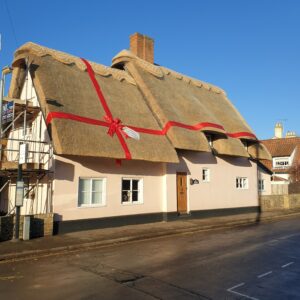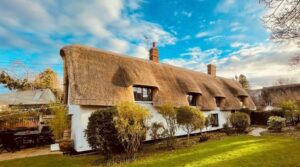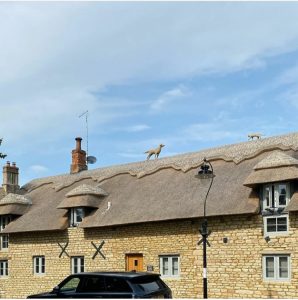Finding out how long a thatched roof is likely to last is one of the first questions you’ll ask yourself before getting a full roof rethatch. Unfortunately, the answer to the question is dependent on both the thatch roof material as well as the skill level of the thatcher, however, we will talk about the average lifespan of a thatched roof below.
When it comes to how long a thatched roof lasts, the following figures are a good ballpark estimate when the thatch has been completed by a skilled master thatcher.
- Water Reed thatch should last from 25 to 40+ years
- Straw thatch from 15 to 25 years
- Ridges need to be replaced every 10 to 15 years
It’s important to note that an unskilled or unqualified thatcher can actually do more harm than good on your building, and some have been known to damage the roof even more. Always choose a reputable company that you can trust when hiring roof thatchers.
Extending the lifespan of your thatched roof
How long does a thatched roof last in the UK
The lifespan of newly thatched roofs can be elongated with proper care and maintenance. Ensure that both you and your contractor take the following precautions when repairing your thatched roof.
- Remove vermin and bird nests from your roof. These can easily cause damage to a thatched roof, leading to leaks and other damage to your roof. Getting your roof thatched by an experienced thatcher will help you avoid any additional unnecessary costs later on.
- Keep your roof well ventilated to allow it to dry out after rainfall. An experienced thatcher will recommend that your roof is kept out of the shade to prevent the likelihood of moss and algae growth.
- Examine the eave, as discolouration or dips in the main coat work often indicates deep rooted damage in the structure of the roof. Do not assume that a neat ridge is a sign of a well-thatched roof. This could just indicate that a previous owner had the roof re-ridged recently. A quality thatcher will examine every part of the roof and let you know of any underlying issues that you may not have noticed.
- Inexperienced and low quality thatchers will often damage the thatch with ladders, tools, or walking on the coat-work. Divots accelerate thatch degradation and should be avoided.
While a thatched roof can be tricky to care for, there are of course many advantages that make it worthwhile:
- Thatch is naturally breathable (more so than slate and tiles) which generally prevents rotting
- Great insulating properties thanks to trapped air bubbles in the straw and reeds. This means that there’s often no need to insulate your loft.
- Thatched roofs are also cool in the summer thanks to low heat conductivity
- Straw and reed are easily harvestable, and don’t require mining which makes them more environmentally friendly when compared to slate and tile roofs.
- They are beautiful and striking, adding character to any property
- Guttering and drainpipes are not required on thatch roofs, saving you money in this area.
- They can increase the value of a home when constructed by a quality thatcher.
High quality straw and reed thatchers
The degradation of your roof is unfortunately inevitable, however, if you enlist the help of master thatchers, your roof will look its best for a long time. At Simply Thatch, we strongly believe that thatch roof maintenance is absolutely essential if you want a thatched roof that stands the test of time. The lifespan of a thatched roof will of course depend on numerous factors, however for best results, let us help you.
Your roof may not require a full rethatch, but instead, require maintenance such as a ridge and repair, moss removal, repairs for damage caused by vermin, repairs to eave lines caught by vehicles (to name a few). If you want to take advantage of our services, get a quote or ask for advice, get in touch with us and we will be happy to help. We offer thatching services in Cambridgeshire, Essex and Suffolk.


